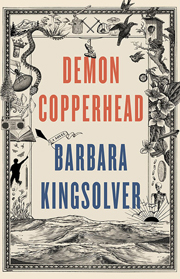 You may know Barbara Kingsolver for her epic novel The Poisonwood Bible, about missionaries in the Congo, Congo independence and its aftermath. It may be her novel The Lacuna, a tale of artistic and political revolution which won her the first of her two Women’s Prizes for Fiction. Or it may be her most recent novel, Demon Copperhead, which won her second, as well as the Pulitzer Prize. You may perhaps not know however, that her fist book was non-fiction, Holding the Line: Women in the Great Arizona Mine Strike of 1983. That book, with its catchy title, is about to be republished in Britain.
You may know Barbara Kingsolver for her epic novel The Poisonwood Bible, about missionaries in the Congo, Congo independence and its aftermath. It may be her novel The Lacuna, a tale of artistic and political revolution which won her the first of her two Women’s Prizes for Fiction. Or it may be her most recent novel, Demon Copperhead, which won her second, as well as the Pulitzer Prize. You may perhaps not know however, that her fist book was non-fiction, Holding the Line: Women in the Great Arizona Mine Strike of 1983. That book, with its catchy title, is about to be republished in Britain.
Early Journalism Shows the Way
It is instructive that Kingsolver’s first book was a work of journalism, and that she focused on a political struggle, and on the role of women in that struggle. The strike was broken when the Reagan government sent in troops, arbitrarily jailed protesters and banned the trades union. As Kingsolver herself said:
‘This was the moment when the forces of capital teamed with governments to crush labour.’
Holding the Line shows how the women of the town of Clifton supported the striking miners, based on observation and interviews after she had won the women’s trust. The book demonstrates Kingsolver’s progressive politics, her interest in social justice and in the role of women.
These are issues which have been the focus of her fiction which has followed and, as a woman living in Appalachia, informs her view of vice-presidential hopeful JD Vance, as this article explores. She is a writer who seeks out the big ideas, which she believes readers appreciate:
‘Give them something bigger than a conversation in a room and they’re going to eat it up.’
 Demon Copperhead
Demon Copperhead
This social awareness comes searingly through Demon Copperhead, her most recent book, a recasting of Charles Dickens’ David Copperfield in the contemporary Appalachians. It explores survival in the grinding poverty and lack of hope in the backwater Appalachians, where ‘40% of children have parents who have either died as a result of opioid addiction, are incapacitated by one, or are in prison.’
As this review by novelist Elizabeth Lowry concludes:
David Copperfield wonders ‘whether I shall turn out to be the hero of my own life’. Demon Copperhead poses a different question: what is heroism, anyway? When you’re a child born into a life without choices, this powerful reworking suggests, being a hero sometimes consists simply of surviving against the odds.
Barbara Kingsolver’s own website is here.
This Wooden… Box
Excavations in London’s Shoreditch area have revealed the remains of an Elizabethan Theatre, the Curtain, where Shakespeare once worked. They were first unearthed a few years ago and caused something of a stir.
 Most of us are familiar with the Globe, if only from the modern reconstruction on the banks of the Thames. It is referred to by the Chorus at the beginning of Shakespeare’s Henry V as ‘this wooden O’. We know that the Blackfriars Theatre, where Shakespeare later worked, was indoors and rectangular.
Most of us are familiar with the Globe, if only from the modern reconstruction on the banks of the Thames. It is referred to by the Chorus at the beginning of Shakespeare’s Henry V as ‘this wooden O’. We know that the Blackfriars Theatre, where Shakespeare later worked, was indoors and rectangular.
The big surprise about the Curtain, which predates the Globe, is that it too was rectangular. As the theatre which likely saw the first performances of Romeo and Juliet, this has caused some radical rethinking of theatrical history. As Henry V is thought to be the first play performed at the Globe, it could well be that the Chorus’ reference to the ‘wooden O’ is not just a general comment on the theatre, which it has been taken to be, but a specific line drawing attention to the novelty of the new theatre’s shape.